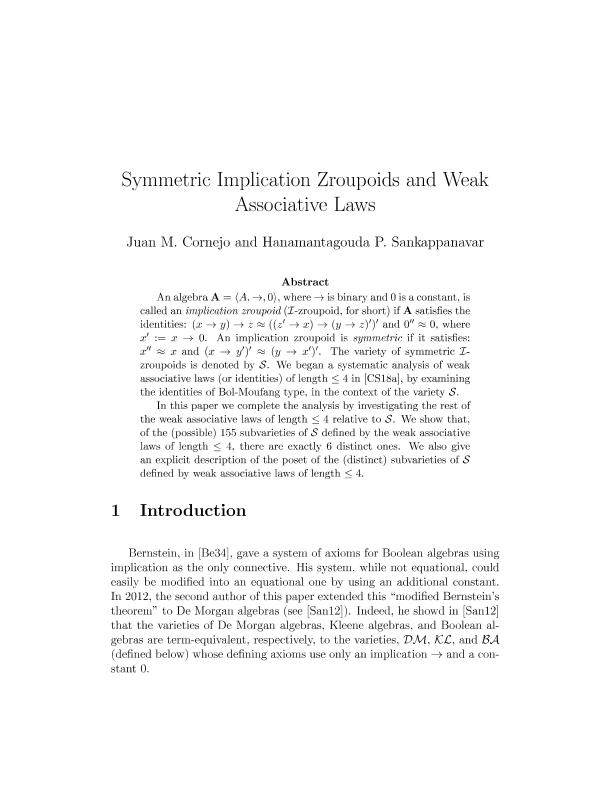Mostrar el registro sencillo del ítem
dc.contributor.author
Cornejo, Juan Manuel

dc.contributor.author
Sankappanavar, Hanamantagouda P.

dc.date.available
2019-12-23T17:38:14Z
dc.date.issued
2019-08
dc.identifier.citation
Cornejo, Juan Manuel; Sankappanavar, Hanamantagouda P.; Symmetric implication zroupoids and weak associative laws; Springer; Soft Computing - (Print); 23; 16; 8-2019; 6797-6812
dc.identifier.issn
1472-7643
dc.identifier.uri
http://hdl.handle.net/11336/92788
dc.description.abstract
An algebra A= ⟨ A, → , 0 ⟩ , where → is binary and 0 is a constant, is called an implication zroupoid (I-zroupoid, for short) if A satisfies the identities: (x→y)→z≈((z′→x)→(y→z)′)′ and 0 ′ ′≈ 0 , where x′: = x→ 0. An implication zroupoid is symmetric if it satisfies: x′ ′≈ x and (x→y′)′≈(y→x′)′. The variety of symmetric I-zroupoids is denoted by S. We began a systematic analysis of weak associative laws (or identities) of length ≤ 4 in Cornejo and Sankappanavar (Soft Comput 22(13):4319–4333, 2018a. https://doi.org/10.1007/s00500-017-2869-z), by examining the identities of Bol–Moufang type, in the context of the variety S. In this paper, we complete the analysis by investigating the rest of the weak associative laws of length ≤ 4 relative to S. We show that, of the (possible) 155 subvarieties of S defined by the weak associative laws of length ≤ 4 , there are exactly 6 distinct ones. We also give an explicit description of the poset of the (distinct) subvarieties of S defined by weak associative laws of length ≤ 4.
dc.format
application/pdf
dc.language.iso
eng
dc.publisher
Springer

dc.rights
info:eu-repo/semantics/openAccess
dc.rights.uri
https://creativecommons.org/licenses/by-nc-sa/2.5/ar/
dc.subject
IDENTITY OF BOL–MOUFANG TYPE
dc.subject
SEMILATTICE WITH LEAST ELEMENT 0
dc.subject
SYMMETRIC IMPLICATION ZROUPOID
dc.subject
WEAK ASSOCIATIVE LAW
dc.subject.classification
Matemática Pura

dc.subject.classification
Matemáticas

dc.subject.classification
CIENCIAS NATURALES Y EXACTAS

dc.title
Symmetric implication zroupoids and weak associative laws
dc.type
info:eu-repo/semantics/article
dc.type
info:ar-repo/semantics/artículo
dc.type
info:eu-repo/semantics/publishedVersion
dc.date.updated
2019-12-11T20:20:50Z
dc.identifier.eissn
1433-7479
dc.journal.volume
23
dc.journal.number
16
dc.journal.pagination
6797-6812
dc.journal.pais
Alemania

dc.journal.ciudad
Berlin
dc.description.fil
Fil: Cornejo, Juan Manuel. Consejo Nacional de Investigaciones Científicas y Técnicas. Centro Científico Tecnológico Conicet - Bahía Blanca. Instituto de Matemática Bahía Blanca. Universidad Nacional del Sur. Departamento de Matemática. Instituto de Matemática Bahía Blanca; Argentina
dc.description.fil
Fil: Sankappanavar, Hanamantagouda P.. State University of New York; Estados Unidos
dc.journal.title
Soft Computing - (Print)

dc.relation.alternativeid
info:eu-repo/semantics/altIdentifier/url/https://link.springer.com/article/10.1007/s00500-018-03701-w
dc.relation.alternativeid
info:eu-repo/semantics/altIdentifier/doi/http://dx.doi.org/10.1007/s00500-018-03701-w
dc.relation.alternativeid
info:eu-repo/semantics/altIdentifier/url/https://arxiv.org/abs/1710.10408
Archivos asociados
